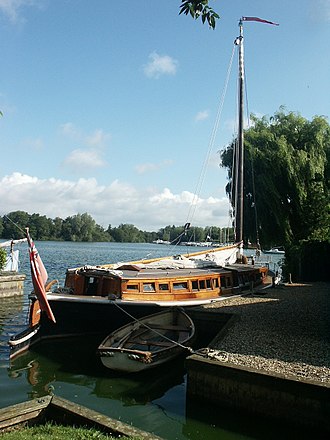History
Hathor (pronounced Har-Tor) was built in 1905 for Ethel and Helen Colman, daughters of Jeremiah Colman and Caroline Colman of the Norwich Colman's Mustard dynasty. Ethel later became the first female Lord Mayor of Norwich in 1923. [1] The wherry was named Hathor in memory of Ethel and Helen's brother Alan Colman who had died in Luxor in 1897 whilst on a convalescent trip with the family; they had travelled the Nile on a boat called Hathor. [3]
Hathor's interior was designed by architect Edward T Boardman, the husband of Florence Colman, sister of Ethel and Helen, and son of Edward Boardman, a leading Norwich architect. The design was based on Egyptian hieroglyphics and mythology, which Boardman's partner Graham Cotman had sketched from originals at the British Museum. [2]
The cost of the basic wherry was £595; with an added £1057 spent on internal woodwork and £407 for other fitting out. Hathor had cabins to sleep six, with extra accommodation for the skipper and steward, and made her maiden voyage on 2 August 1905. [2]
Hathor remained in the Colman/Boardman family until 1954 when she was sold to Claud Hamilton, author of Hamilton's Guides to the Broads, who owned her for almost 10 years. She was then sold on and used as a houseboat (with a token mast) at Martham until 1985 when the Wherry Yacht Charter Trust purchased her in a dilapidated state and undertook an extensive two-year restoration. [1]
Hathor is currently in full sailing order and fitted out to charter standard. [4]
This page is based on this
Wikipedia article Text is available under the
CC BY-SA 4.0 license; additional terms may apply.
Images, videos and audio are available under their respective licenses.
